Fokker-Flugzeugwerke Dr.I Dreidecker (triplane)
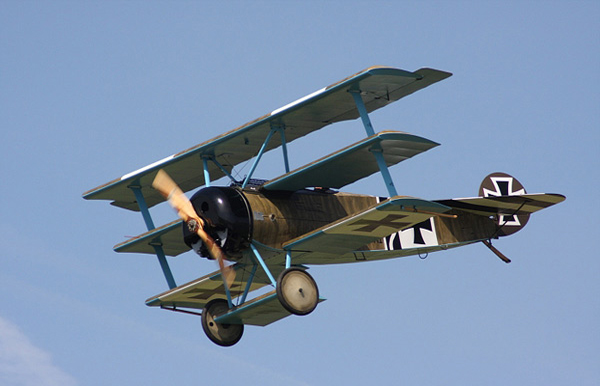
Fokker Dr.I Triplane (replica) PFA 238-14043 G-CDXR/403/17. Photo by Bob Franklin
The Fokker Dr.I triplane built by Fokker-Flugzeugwerke was a World War I fighter plane. The first flight of the Fokker Dr.I triplane was on 5th July 1917. It saw widespread service during the Spring of 1918. The Fokker Dr.I triplane became renowned as the aircraft of the German flying ace Manfred von Richthofen during the First World War, in which he achieved his last twenty victories and was also killed in one on 21st April 1918. In total 320 were built and they were mainly used by The Deutsche Luftstreitkrafte.
During February 1917 the Sopwith Triplane started to appear over the Western Front. The Sopwith Triplane was far superior to the Luftstreitkrafte's Albatros, this prompted Fokker-Flugzeugwerke to convert an unfinished biplane prototype into the V.4, which was a small, rotary-powered triplane. Rather than submitting the V.4 for a type test, Fokker produced a revised prototype which was designated V.5. The V.5 had a number of changes, including the horn-balanced ailerons and elevators and the longer-span wings. On 14th July 1917 Idflieg (Inspektion der Fliegertruppen - Inspectorate of Flying Troops) issued an order for twenty pre-production aircraft. The V.5 prototype (serial 101/17) was tested to destruction at Adlershof on 11th August 1917.
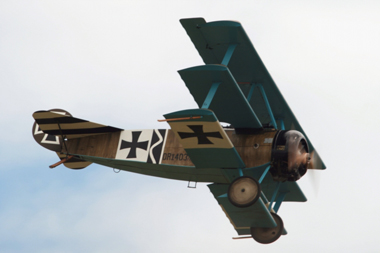
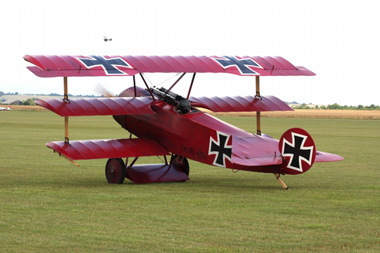
Fokker Dr.I Triplane (replica) PFA 238-14043 G-CDXR 403/17
Fokker Dr.I Triplane (replica) PFA 238-14253 G-FOKK 477/17
Images courtesy of John Bradshaw and Bob Franklin
Fokker produced two pre-production triplanes, designated F.I, serial numbers 102/17 and 103/17. These could be distinguished from the production Dr.I aircraft by a curve to the tailplane leading edge. Manfred von Richthofen first flew 102/17 on 1st September 1917 and he shot down two enemy aircraft in the next two days. Richthofen reported to the Kogenluft (Kommandierender General der Luftstreitkrafte) that the F.I was superior to the Sopwith Triplane. Richthofen recommended that fighter squadrons be re-equipped with the new aircraft as soon as possible. Idflieg issued a production order of over 300 triplanes. In comparison to the Albatros and Pfalz fighter planes the Dr.I had far greater manoeuvrability. Even though the ailerons weren't great the rudder and elevator controls were both light and powerful. The Fokker Dr.I had a few other problems, the cockpit was fitted with poor quality materials, during takeoff and landing the view from the cockpit was very poor and also with the gun butts being so close to the cockpit this left the pilot vulnerable to serious head injuries during a crash landing.
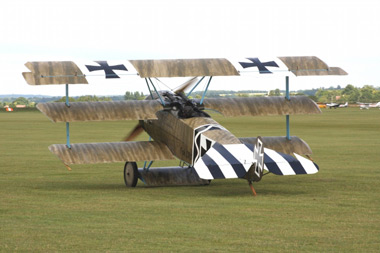
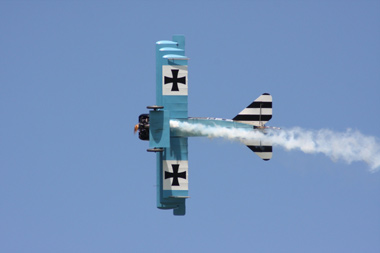
Fokker Dr.I Triplane (replica) PFA 238-14043 G-CDXR 403/17
Fokker Dr.I Triplane (replica) PFA 238-14043 G-CDXR/403/17
Images courtesy of Bob Franklin
Only a few triplanes survived the Armistice. A Fokker with the serial number 528/17 was kept as a testbed by The Deutschen Versuchsanstalt fur Luftfahrt (German Aviation Research Institute) at Adlershof. 528/17 was used during the filming of two movies and is believed to have crashed around the late 1930s. A Fokker in which Manfred von Richthofen gained three victories was displayed at The Zeughaus Museum in Berlin. It was destroyed during World War II by an allied bombing raid. As of today only a few original Dr.I artefacts survive in museums.
There are no surviving Dr.I airframes but there are plenty of flying and static reproductions that have been built. During 1932 Fokker managed to build a replica Dr.I using the spare parts of various aircraft. The replica appeared in the 1939 film D III 88. Two Dr.I replicas were built by Bitz Flugzeugbau GmbH to be used in the Twentieth Century Fox film The Blue Max, made in 1966. The Omaka Aviation Heritage Centre in Blenheim, New Zealand keep four airworthy aircraft and The Great War Flying Museum in Brampton, Ontario operates two. There are also two examples of the Fokker Dr.I on display at The Old Rhinebeck Aerodrome in Rhinebeck in New York.




